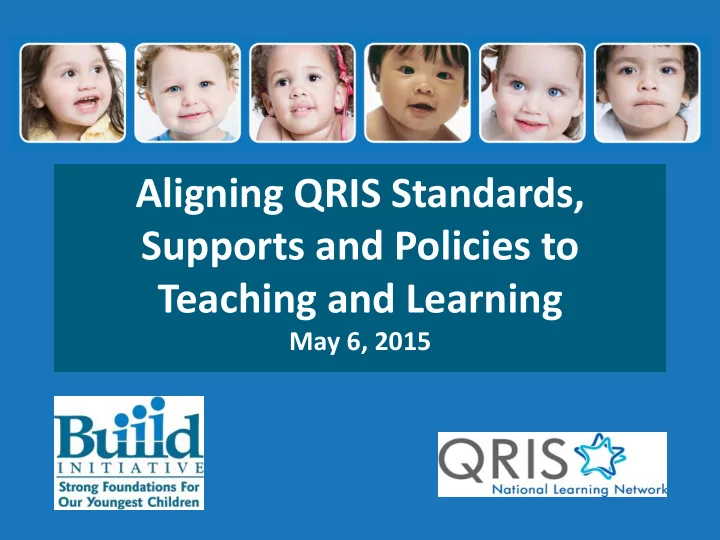

Aligning QRIS Standards, Supports and Policies to Teaching and Learning May 6, 2015
Introductions
Agenda for the Conversation • Historic Context • Theory of Change • Who are the children? • Teaching and Learning • Elements of QRIS
A Systems Approach Many systems approaches available; Here is the Early Childhood Systems Working Group framework, which focuses on : • Outcomes • Necessary Systems and Services • Values and Principles • Core Strategies
Historical Context Welfare Reform • From work support to school readiness • Federal and State spending on child care skyrocketed between 1995-2009 • Focus on increasing supply; little attention to policies that support provider quality • Result: dramatic government cost increase without corresponding improvement in quality or child outcomes
Historical Context The Great Recession Added New Challenges • As child care demand boomed pre-recession, cost/quality challenges not as apparent • With recession, ECE programs that serve all socioeconomic sectors suffering from: – Lower enrollment – Insufficient fee collection – Pressure to lower prices • End result: Oversupply of poor- and mediocre quality programs, significant fiscal challenges for higher quality programs
Historical Context Federal Direction to Improve School Readiness • Race to the Top Early Learning Challenge – Grants shifted focus from access to quality – Clearly focused on standards- based ‘system’ – standards for learning, for professionals and standards for program – Required a “T”QRIS • Increased focus on quality from Office of Child Care - Child Care Development Fund Reporting
Historical Context • NAEYC Accreditation define quality practices – the North Star • Brain Research • Accountability, ROI and Results • Using Research to inform practice
States Considering Theory of Change What is the Vision for QRIS? What Levers are used to progress to that vision? The use of tools and models: • Logic Models to demonstrate inputs and outcomes • How is implementation science being used to provide a conceptual framework? • What does the ‘end’ look like? • What are best and promising practices?
Goals of the QRIS – Zaslow/Tout (QRIS NLN Meeting July 2013) • Improved child outcomes and school readiness • Professionalization of the ECE Workforce and Instructional Leaders • Improving ECE as a System • Enhancing Family Outcomes
Lets Talk What is your reaction to states defining and tracking other goals (besides child outcomes) of the QRIS?
The Importance of Data What data drives your state’s policies to improve teaching and learning ?
Who are the At Risk Children?
Lets Talk What is Teaching Quality? Discussion: – What does good teaching looks like? – How would we know? – What makes an “excellent” teacher? – How would we know?
No other intervention can make the difference that a knowledgeable skillful teacher can make in the learning process (Darling-Hammond, 1997)
Teaching Quality Teaching Quality = Strong Instruction = Students Learn Teaching Quality = Teacher Quality + Context of Instruction Teacher Quality – Knowledge – Skills – Dispositions Context of Instruction – Curriculum and assessment system – “Fit” between teachers’ qualifications and what they are asked to teach – Teaching conditions (e.g., time, class size, facilities, and materials)
State Policy To Promote Effective Teaching That Improves Children’s Learning Guiding questions for states: 1. What are the consistent supports and sensible accountability systems needed to drive teaching quality that will result in improved outcomes for children? 2. What guidance and advice can we give to states about the “powerful and few” core state policies that improve teaching quality and result in significant outcomes for children?
Teaching Quality: Theory Of Change Teacher Knowledge, Skills and Dispositions Teacher Quality Context of Instruction Teaching Quality Children's Learning Human and Conditions of Teaching Organizational Resources Pro rofe fessi sional nal Devel velopme opment nt and d Ac Accounta ntabi bility ty St Structures ctures
Moving Toward Solutions: Research – Policy – Practice • What are effective teaching practices that result in significant learning outcomes for young children? – high quality learning environments must be coupled with highly intentional and developmentally appropriate instruction • How do we move these practices into policy and practice? • A Question of Implementation – Evidence-based Approaches – State and Local Capacity – Policy Coherence
Four Problems of Practice 1. Focusing Professional Development Policies on Effective Teaching Practices 2. Streamlining Accountability Structures that Impact Teaching Quality 3. Integrating Teaching Conditions into States’ Professional Development and Accountability Structures 4. Ensuring Racially, Culturally, and Linguistically Competent Teaching
Elements of QRIS QRIS can be framework for early care and education system reform …
Standards
System Planning and Accountability
Supports for Improvement
Financing
Engagement and Outreach
The Challenges In Early Care And Education--Equity • Creating equitable, high quality early care and education systems that have sufficient policies, programs and capacities in place to support and sustain optimal developmental and educational outcomes for all children, including the most vulnerable. • Creating a workforce at all levels that is able to provide equitable, high quality, culturally responsive, intellectually rigorous, and emotionally supportive care and education for children, including the most vulnerable. 28 from a presentation by Aisha Ray, Ph.D. Senior Vice President for Academic Affairs and Dean of Faculty
Questions, Reflections, Comments?
Access presentations and resources at http://buildinitiative.org/OurWork/StateandLocal/EarlyLearningChallenge/SmartStart2015.aspx BUILD’s RTT -ELC E-Book chapters will be posted at the above link. Check back! Connect with us on Twitter and Facebook using #BUILDatSmartStart2015
For More information Debi Mathias, Director QRIS NLN BUILD Initiative dmathias@buildinitiative.org www.qrisnetwork.org
Recommend
More recommend